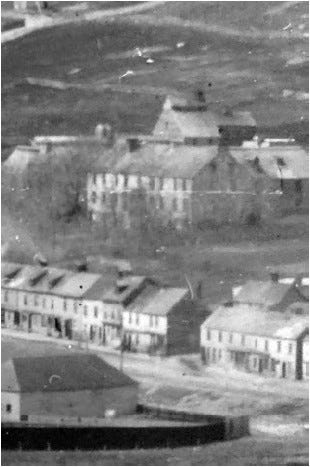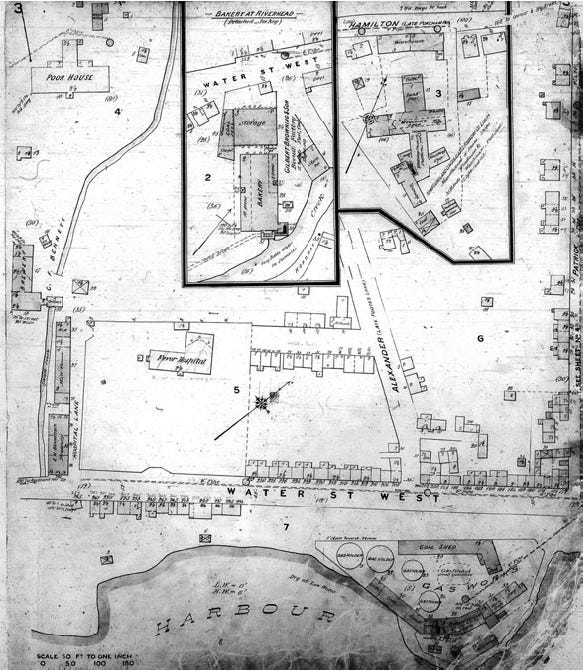The Riverhead Hospital, St. John's, 1800's
A true script for a season of "American Horror Story"
Did you know that there was once a hospital constructed on the grounds of what is now known as Victoria Park located on Water Street West, St. John’s? I did not know this until doing some research about hospitals in Newfoundland. I always felt a darkness and thick dread whenever I visited that area of St. John’s. Victoria Park is my least favourite park in the City for that reason. There is always a darkness that follows me in that area, it feels like tortured souls crying out for release.
Riverhead Hospital was constructed in 1813 and opened its doors to patients in 1814 with lots of help and enthusiasm from the locals as they fought long and hard for a health care facility. St. John’s did not have the best reputation in the early 1800’s, there would be fish waste thrown along the streets and human waste and garbage piled in areas. One can imagine the stench this would have caused on hot summer days. There was little to no medical care and little help or funding from Britain. Joseph Banks, the eminent English naturalist, described St. John’s in 1766 in his diaries as
“the most disagreeable town” he had ever visited. He continued in his entry for 16 October:.
Built upon the side of a hill facing the harbour containing two or three hundred houses and near as many fish flakes interspersed which summertime must cause a stench scarce to be supported . . . . For dirt and filth of all kinds St. John’s may in my opinion reign unrivalled as far as it exceeds any fishing town I saw in England. Here is no regular street the houses being built in rows immediately adjoining to the flakes. Consequently[,] no pavement[,] offals of fish of all kinds are strewd about, the remains of the Irish mens [sic] chowder who you see making it skinning and gutting fish in every corner. (Lysaght 1971, 146–47)
These conditions were obvious breathing grounds for all kinds of illnesses.
A plot of land was arranged “in the country” surrounded by a beautiful green forest. The hospital was also known as the “Fever Hospital” as well as The Riverhead Hospital.
Riverhead was a two-story building with a basement. The wards and rooms were known to be gloomy and dark. There was limited running water and patients had to use outdoor bathrooms which included an onsite cesspool. Bathroom facilities were non-existent inside the hospital along with bathtubs.
The violent, mentally ill patients were kept in basement cells and the chronically ill were kept on the second floor for long term care. During the winter, the wards were bitter cold due to the lack of heating. Snow would enter in around the windows and there would be frosty floors beneath the feet of patients and hospital staff. In the Basement, where the violent patients were kept, conditions were far worse. In 1835 it was noted by Chief Justice Boulton:
“a scene of wretchedness and misery…which must be heart-rending to anyone whose minds are imbued with the smallest tinge of humanity”.
The Basement was damp and cold with stagnant air circling constantly carrying around a foul stench. The Basement was a commonly used area, nevertheless. It held the kitchens, storerooms, vegetable and coal cellars, the apothecary, nurses’ living quarters, and the physician’s consulting room. It was common for the housed nurses to contract illnesses living in close quarters to the patients.
The most disturbing account was by Dr. Henry Hunt Stabb, who later founded the Waterford Hospital. He noted that during his time at Riverhead, he had seen mentally ill patients that were there chained to benches and walls, covered with filth and vermin, exposed to below freezing temperatures being fed by tin cups tied to long poles which he believed that this was a crime again humanity.
It is assumed that the last known Beothuk of Newfoundland, a woman known as Shanawdithit, died on June 6, 1829, of Tuberculosis. In Shanawdithit’s obituary, it reported that she had died “at the Hospital,” which was another name for the Riverhead Hospital.
People and Government alike were agreeable that The Riverhead Hospital was a dark omen for St. John’s and it was decided that to get rid of the entire establishment and construct a Park on the grounds. It was later burned to the ground while being supervised by the local fireman during the dark night so there wouldn’t be too many spectators. Everything that remained was buried and later became what is now known as Victoria Park.
Who knows what lies beneath…maybe graves of those tortured souls that once called this horrifying place home. The safety of being recognized as a community park has prevented any digging for remnants or graves, for that matter.
What makes this account ironic, is the fact that Newfoundland is currently in another health care crisis but not far as disturbing as the 1800’s.
Resources:






This made me laugh quite a bit but basically yes! There are so many dark things in the history of NL that are not talked about and stuff most people don't really care about and that is what I like to indulge into!
So St. John's was basically the Mos Eisley of its time?